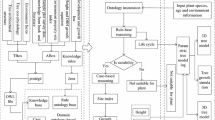Abstract
A Forest Planning Language and Simulator (FORPLAN) has been developed to facilitate the use of simulation for integrating fire into the land management planning process.FORPLAN incorporates unique characteristics of previous systems, links numerous models and data bases, allows selection of variable resolution levels, and permits discrete time simulation of disturbances on plants, fuels, and animals. No previous computer experience is required of the user, sinceFORPLAN recognizes simple English words and phrases.
Similar content being viewed by others
Literature cited
Albini, F. A. 1976. Computer-based models of wildland behavior: a users' manual. USDA Forest Service INT. 68 pp.
Bevins, C. D. 1976. Fire modeling for natural fuel situations in Glacier National Park. First Conf. on Scientific Research in the National Parks, New Orleans, La. November 1976. in press.
Botkin, D. B., J. F. Janak, and J. R. Wallis. 1972. Some ecological consequences of a computer model of forest growth. J. Ecol. 60:849–872.
Cattelino, P. J., I. R. Noble, R. O. Slatyer, and S. R. Kessell. 1979. Predicting the multiple pathways of plant succession. Environmental Management 3(1):41–50.
Deeming, J. E., R. E. Burgan, and J. D. Cohen. 1977. The National Fire Danger Rating System-1978. USDA Forest Service Gen. Tech. Rep. INT-39. 63 pp.
Franklin, J. F. 1979. Simulation modeling and resource management. Environmental Management 3(1):2–5.
Franklin, J. F., and C. T. Dyrness. 1973. Natural vegetation of Oregon and Washington. USDA Forest Service Gen. Tech. Rep. PNW-8. 417 pp.
Furman, W. R., and G. E. Brink. 1975. The National Fire Weather Data Library: what it is and how to use it. USDA Forest Service Gen. Tech. Rep. RM-19. 8 pp.
Gustafson, J. D., and G. S. Innis. 1973. SIMCOMP: Version 3.0 User's Manual. US IBP Grasslands Biome, Colorado State Univ., Ft. Collins, CO. Tech. Rep. 218.
Hall, F. C. 1973. Plant communities of the Blue Mountains in eastern Oregon and southeastern Washington. USDA Forest Service Region 6 Area Guide 3-1. 62 pp.
Helfman, R. C., J. E. Deeming, R. J. Straub, and R. W. Furman. 1975. Users guide to AFFIRMS: time-share computerized processing for fire danger rating. USDA Forest Service Gen. Tech. Rep. RM-15. 107 pp.
Kessell, S. R. 1976a. Gradient modeling: a new approach to fire modeling and wilderness resource management. Environmental Management 1(1):39–48.
—. 1976b. Wildland inventories and fire modeling by gradient analysis in Glacier National Park. Pages 115–162 in Proc. 1974 Joint Tall Timbers Fire Ecology Conf. and Intermountain Fire Res. Council Fire and Land Management Symp.
—. 1977. Gradient modeling: a new approach to fire modeling and resource management. Pages 575–605in C. A. S. Hall and J. W. Day, Jr., eds. Ecosystem Modeling in Theory and Practice: an Introduction with Case Histories. Wiley, New York.
—. 1979a. Gradient modeling. Springer Series on Environmental Management 1. Springer-Verlag, New York. In press.
—. 1979b. Phytosociological inference and resource management. Environmental Management 3(1):29–40.
Kessell, S. R., C. D. Bevins, L. Bradshaw, B. W. Jeske, M. W. Potter, and D. B. Dwyer. 1977. Final report to supplement 3 between USDA Forest Service Intermountain Forest & Range Exp. Sta. and Gradient Modeling, Inc.: fire management information integration system (GANDALF). 248 pp.
Kessell, S. R., and P. J. Cattelino. 1978. Evaluation of a fire behavior information integration system for southern California chaparral wildlands. Environmental Management 2(2):135–159.
Kessell, S. R., P. J. Cattelino, and M. W. Potter. 1977b. A fire behavior information integration system for southern California chaparral. Pages 354–360in Proc. of the Symp. on the Environmental Consequences of Fire and Fuel Management in Mediterranean Climate Ecosystems. Palo Alto, CA. USDA Forest Service Gen. Tech. Rep. WO-3. 498 pp.
Kessell, S. R., M. W. Potter, C. D. Bevins, L. Bradshaw, and B. W. Jeske. 1978. Analysis and application of forest fuels data. Environmental Management 2(4):347–363.
Lotan, J. E. 1978. Integrating fire management into land-use planning: a multiple-use management research, development, and applications program. Environmental Management 3(1):7–14.
Markowitz, H. M., B. Hausner, and H. W. Karr. 1962. SIM-SCRIPT: a simulation programming language. Prentice-Hall, Englewood Cliffs, New Jersey.
Noble, I. R., and R. O. Slatyer. 1977. Post-fire succession of plants in Mediterranean ecosystems. Pages 27–36in Proc. of the Symp. on the Environmental Consequences of Fire and Fuel Management in Mediterranean Climate Ecosystems. Palo Alto, CA. USDA Forest Service Gen. Tech. Rep. WO-3. 498 pp.
Pfister, R. D., B. L. Kovalchik, S. F. Arno, and R. C. Presby. 1977. Forest habitat types of Montana. USDA Forest Service Gen. Tech. Rep. INT-34. 174 pp.
Potter, M. W., S. R. Kessell, and P. J. Cattelino. 1978. FORPLAN (FORest Planning LANguage and Simulator) User's Guide. 2nd ed. Gradient Modeling, Inc., Missoula, MT. 75 pp.
Pritsker, A. A. G., and P. J. Kiviat. 1969. Simulation with GASP II. Prentice-Hall, Englewood Cliffs, New Jersey.
Rothermel, R. C. 1972. A mathematical model for predicting fire spread in wildland fuels. USDA Forest Service Res. Paper INT-115. 40pp.
Schriber, T. J. 1974. Simulation using GPSS. Wiley, New York.
Stage, A. R. 1973. Prognosis model for stand development. USDA Forest Service Res. Paper INT-137. 32 pp.
Storey, T. G. 1972. FOCUS: a computer simulation model for fire control planning. Fire Technology 8(2):91–103.
Thomas, J. W., R. Miller, C. Maser, R. Anderson, and B. Carter. 1977. The relationship of terrestrial vertebrates to plant communities and their successional stages. To appear as USDA Forest Service Gen. Tech. Rep.
Author information
Authors and Affiliations
Rights and permissions
About this article
Cite this article
Potter, M.W., Kessell, S.R. & Cattelino, P.J. FORPLAN: A FORest Planning LANguage and Simulator. Environmental Management 3, 59–72 (1979). https://doi.org/10.1007/BF01867069
Issue Date:
DOI: https://doi.org/10.1007/BF01867069



